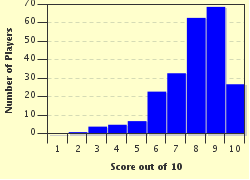Quiz Answer Key and Fun Facts
1. The first inspirational person to appear in this quiz is Agnes Gonxha Bojaxhiu. Born an Albanian in 1910 in what is now Macedonia, Agnes devoted her life to being a Roman Catholic nun. She founded the Missionaries of Charity, helping to provide care, food and education for the "poorest of the poor" around the world. In 1979 she was awarded the Nobel Peace Prize - but refused the banquet, asking that the $192,000 be given to India's poor instead.
But by what name did this remarkable lady become known during her lifetime?
2. The second question, and another Nobel Peace Prize winner! Martin Luther King, Jr. (1929-1968) was an American activist, minister, and leader in the African American Civil Rights Movement. He was assassinated in Memphis, Tennessee, whilst supporting black public service workers, and James Earl Ray was convicted of his murder. During his short life, King achieved so much to improve the lives of black people in America, especially during one particularly rousing 1963 speech. What was the name of his most famous speech?
3. Florence Nightingale (1820-1910) is famous for her pioneering work in nursing and healthcare, particularly during the Crimean War, where she became known as the 'Lady with the Lamp'. However, she was also a prominent statistician and in fact developed a type of pie chart.
4. Helen Keller was born in Alabama in the US in 1880. She became a world-famous author and speaker, as well as an advocate for the disabled, a suffragist, pacifist, and radical socialist. She overcame massive personal obstacles to achieve more than anyone thought possible. What made her so exceptional?
5. Mohandas (Mahatma) Gandhi (1869-1948), a preeminent Indian nationalist, led India to independence from British rule in 1947, having employed non-violent civil disobedience techniques for decades. A devout Hindu and strict vegetarian, he fasted for long periods of time in political protest and self-purification. His untimely death came in 1948 as he addressed a prayer meeting. How did he die?
6. Our sixth inspirational person is Nelson Mandela (born in 1918). Despite being sentenced to life imprisonment, and serving 27 years, on charges of sabotage, Mandela became instrumental in the anti-apartheid movement of which African country?
7. Often cited as one of the greatest people to change the world is Joan of Arc. She was a poor peasant girl born in eastern France in around 1412. Whilst just in her teenage years, she declared she was being divinely guided, and must lead the French army to victory over the English during the Hundred Years War - something which she duely did. However, at the age of 19, she was tried for heresy and put to death. How did she die?
8. Diana, Princess of Wales (1961-1997) became known at the end of her short life as 'the People's Princess', and campaigned tirelessly in developing countries in order to improve their quality of living and safety. She did not use her royal status as a reason to be above those who lived with disease and destitution. With which of the following causes was she associated?
9. Here we have another Nobel Peace Prize winner! Desmond Tutu (born 1931) is a South African political activist and retired bishop of the Anglican church. He is especially well known for his anti-apartheid views, though he has also used his high profile in the fight against AIDS, tuberculosis, homophobia, poverty and racism. He was also an academic, gaining both a Bachelor's and Master's degree in Theology between 1962-1966 - from which British university?
10. Last but by no means least, is someone perhaps just as well known for his contribution to music as to reducing world poverty. Born in Ireland in 1951, Sir Bob Geldof initially found fame in the punk band The Boomtown Rats. In 1981, he was invited to perform at an Amnesty International concert - and thus began his involvment in human rights. In 1985, in response to terrible African famine, he organised one of the biggest music concerts ever seen to raise money and awareness for famine. What was the name of this concert?
Source: Author
crazy baby
This quiz was reviewed by FunTrivia editor
bloomsby before going online.
Any errors found in FunTrivia content are routinely corrected through our feedback system.

